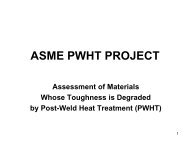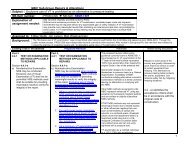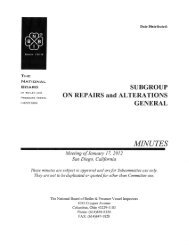DRAFT BOILER/FEEDWATER GUIDELINES - The National Board of ...
DRAFT BOILER/FEEDWATER GUIDELINES - The National Board of ...
DRAFT BOILER/FEEDWATER GUIDELINES - The National Board of ...
You also want an ePaper? Increase the reach of your titles
YUMPU automatically turns print PDFs into web optimized ePapers that Google loves.
for carbon dioxide and oxygen. As the condensate cools, it becomes easier for<br />
gasses, such as carbon dioxide and oxygen to dissolve in the water.<br />
2.2.3.1 Carbon dioxide is absorbed by the cooling condensate causing it<br />
to become acidic creating a similar condition as “acid rain” found in the<br />
earth’s hydrological cycle. <strong>The</strong> acidic condition erodes iron pipes,<br />
creating a trench in the bottom <strong>of</strong> condensate piping and sometimes all the<br />
way through the pipe.<br />
2.2.4 Free oxygen also joins with the cooling condensate. Pits or holes in iron<br />
are caused by excessive oxygen in the boiler/feedwater. <strong>The</strong>se pits are called<br />
“tubercles.”<br />
2.2.5 Iron, eaten away by “acid rain” and oxygen corrosion is transported to the<br />
boiler where it becomes an insulating deposit; it restricts heat transfer which can<br />
causes heat stress damage to the tubes and fuel waste.<br />
2.2.5.1 If the iron laden condensate leaks out <strong>of</strong> the system enroute to the<br />
boiler it usually will form an orange stain on the floor or other equipment.<br />
When observed this orange stain is an indication that water control<br />
practices should be reviewed.<br />
3.0 WATER TREATMENT OBJECTIVES<br />
3.1 External and Internal Water Treatment<br />
3.1.1 Proper treatment <strong>of</strong> makeup and feedwater is necessary to prevent scale,<br />
other deposits and corrosion in pre-boiler, boiler, steam and condensate systems,<br />
and to provide the required steam purity. Absence <strong>of</strong> adequate external and<br />
internal treatment can lead to operational upsets or unscheduled outages; it is also<br />
ill advised from the point <strong>of</strong> view <strong>of</strong> safety, economy, and reliability. When given<br />
a choice the reduction or removal <strong>of</strong> objectionable constituents by pretreatment<br />
external to the boiler is always preferable to and more reliable than, management<br />
<strong>of</strong> these constituents within the boiler by internal chemical treatment.<br />
3.2 Oxygen Corrosion<br />
3.2.1 Oxygen in the presences <strong>of</strong> cool water, less than 212° F, can cause a<br />
seriously destructive activity called oxygen corrosion. <strong>The</strong> oxygen is absorbed<br />
into water in proportion to temperature and pressure; see examples below:<br />
70° F water at 0 psig can contain oxygen approximately equal to 8.6 ppm;<br />
150° F water at 0 psig can contain oxygen approximately equal to 4.3 ppm; and<br />
212° F water at 0 psig can contain oxygen approximately equal to 0.0 ppm.<br />
3








